27th January 2008 : Birds, Planes & Pachyderms
 Tuesday, January 29, 2008 at 11:06PM
Tuesday, January 29, 2008 at 11:06PM
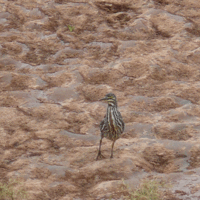
Juvenile Green-backed Heron seeming unsure of itself out in the open
click any image to enlarge
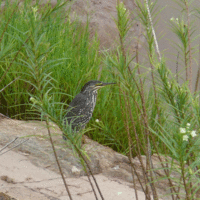
This is more like it...staying close to the reeds...
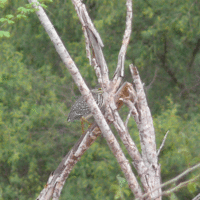
Hang on a minute...what on earth is it doing crawling up a tree?
Talking of strange bird behaviour (following on from yesterday’s strange Falcon pursuit of the Ibis), one of the Green-backed Herons was acting in a most extraordinary way this morning – I’m wondering whether it was actually a youngster and not yet sure of itself, or sure of how Green-backed Herons normally behave. First it landed on the riverbank, and hopped around nervously, looking very nervous right out in the open (not surprisingly, as these Herons normally skulk around at the river’s edge), and then it kept flying/hopping from one spot to the next. Then, all of sudden, it flew up into one of the spindly acacia tomasi trees at the river’s edge, crawled up along the branches, and then from there took flight again and landed right at the top of the tallest tree around. I really don’t know what was going on with it, but certainly it was behaving strangely for a Green-backed Heron, which is usually a riverbank skulker!
[Later: I looked at my photos in more detail, and consulted my bird book, and yes, this is definitely a young bird – you can tell by the distinctive streaking on the chest, which is not so pronounced on an adult bird. Not surprisingly, the other name for this bird is the Striated Heron.)
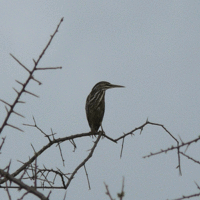
Young Green-backed Heron in the treetops...
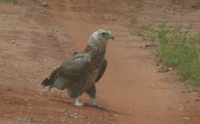
A juvenile Bateleur Eagle finishing off his meal on the road, photographed through our windscreen en route to Tsavo West
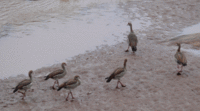
Two parents plus four nearly-grown goslings on this dull grey morning
The parent Egyptian Geese plus four big goslings were here this morning, which by the way, is a very grey overcast morning – not at all what we are used to in January when the sun is meant to be scorching with no clouds in sight. The river is low again.
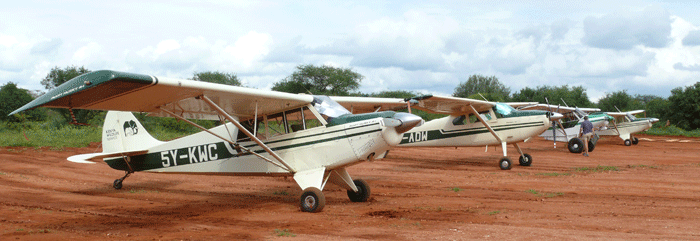
Every three years (to coincide with the inter-calving interval of elephants), the Kenya Wildlife Service (KWS), in conjunction with volunteers and donors, carries out an aerial survey of the entire Tsavo Ecosystem (an area larger than Switzerland) to count the number of elephants and other mammals living in the area. This is part of their international obligations to CITES (Convention on International Trade in Endangered Species) and the MIKE programme (Monitoring of Illegally Killed Elephants), but is also extremely important on a local conservation and tourism level – after all, in Tsavo, Kenya can boast the world’s largest elephant range in the world. All elephant range states are meant to carry out similar surveys, but I think it is safe to say that Kenya is amongst the leaders when it comes to professionalism and adherence to the MIKE / CITES criteria.
What I love most about the Tsavo Elephant Count is how it brings people together from all corners of Kenya – not just the KWS pilots and scientists, but volunteers from other conservation organizations, safari operators, ranch owners, and even just flight-enthusiast volunteers. People come with their aircraft, their knowledge and their enthusiasm, and all together, the most amazing survey of this huge tract of land is methodically carried out. That’s not to say that there’s not a good deal of fun to be had too (and dare we admit, a few headaches in the mornings!) but what strikes me most of all is the team effort – especially at a time like this, when Kenyans in some parts of the country seem more divided than ever. The Tsavo Elephant Count this year is living proof that most Kenyans simply want to get on with their lives, get on with moving their country forward, and can and do unite quite happily to pursue a shared agenda.
This year, the count is based from the Kilaguni Serena Lodge in Tsavo West, from where each morning just after dawn, you will see ten or more aircraft take off from the dusty airstrip and head off towards their allocated ‘blocks’ which they will survey by flying transects up and down until they have counted all the mammals in that area. They record their findings on data sheets and GPS.
Ian (my husband) is one of the counters, and is flying with our friend Richard, who has come down to Tsavo from the Lewa Wildlife Conservancy where he works, to volunteer not only his time, but Lewa’s brand new Supercub aircraft. (Today is only the second day he’s flown it!) The whole operation is being coordinated by our great friend Danny, who is the Senior Warden of Tsavo West and himself an experienced bush pilot.
Ian & Richard with their not-so-useful map!
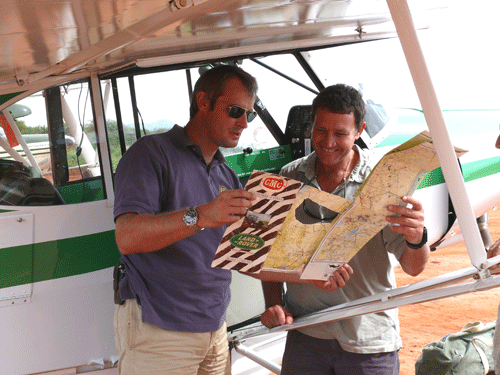
Today was the first day of the count, which will go on all week (check for updates on this blog!). Everyone congregated at Kilaguni, the excitement mounting as each new aircraft arrived and ‘reported for duty’, and briefings were given. Then a couple of aircraft did a quick test flight at last light, ready for the counting proper to begin in the morning.
I decided to stay the first night with them all in Tsavo West (one of the most scenically spectacular of Kenya’s parks), to see them all off in the morning, and to catch up with friends too: in addition to the serious task at hand, events like these always have a social element to them, with a group of like-minded people (many of whom are old friends) congregating with a shared aim, and this one is no different…

More in Pictures:
Tsavo Elephant Count 2008
Birds photographed in January
Egyptian Goose Family from the beginning
If you're interested in more aircraft stories, why not check out our Christmas by Microlight photos?
From the air: see the kind of terrain the pilots are flying over...





Reader Comments (7)
What a fabulous story, thanks, - brings back many many happy memories. Lived all my life except the last 18 years in Kenya and visited Tsavo many times.
Hello Bill -
Nice to hear from you - interesting to read that you spent so much time here in Kenya and that Tsavo holds a special place in your heart too. I certainly think Tsavo - both East and West in their own different ways - is a magical place. I've just spent a few days over in Tsavo West with the elephant count, and will be writing more about that as soon as I can...
Take care,
Tanya
How wonderful to see your diary.
I will be back for a longer visit soon.
Hi Nina,
Thanks for stopping by! I had a look at your blog too - it's fun to see that you and I are essentially doing much the same thing - documenting the course of nature around our homes - but from opposite sides of the world!
Take care,
Tanya
Never realised how much work it was to count those elephants. We should really ask them if they couldn't line up properly so we could count them. :D
I know, Manictastic, they are so inconsiderate! ;-)
When I mentioned Laikipia before -- I stayed at Lewa for those two weeks.